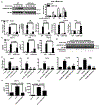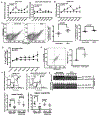Mitochondrial Metabolic Reprogramming by CD36 Signaling Drives Macrophage Inflammatory Responses
- PMID: 31625810
- PMCID: PMC6921463
- DOI: 10.1161/CIRCRESAHA.119.315833
Mitochondrial Metabolic Reprogramming by CD36 Signaling Drives Macrophage Inflammatory Responses
Abstract
Rationale: A hallmark of chronic inflammatory disorders is persistence of proinflammatory macrophages in diseased tissues. In atherosclerosis, this is associated with dyslipidemia and oxidative stress, but mechanisms linking these phenomena to macrophage activation remain incompletely understood.
Objective: To investigate mechanisms linking dyslipidemia, oxidative stress, and macrophage activation through modulation of immunometabolism and to explore therapeutic potential targeting specific metabolic pathways.
Methods and results: Using a combination of biochemical, immunologic, and ex vivo cell metabolic studies, we report that CD36 mediates a mitochondrial metabolic switch from oxidative phosphorylation to superoxide production in response to its ligand, oxidized LDL (low-density lipoprotein). Mitochondrial-specific inhibition of superoxide inhibited oxidized LDL-induced NF-κB (nuclear factor-κB) activation and inflammatory cytokine generation. RNA sequencing, flow cytometry, 3H-labeled palmitic acid uptake, lipidomic analysis, confocal and electron microscopy imaging, and functional energetics revealed that oxidized LDL upregulated effectors of long-chain fatty acid uptake and mitochondrial import, while downregulating fatty acid oxidation and inhibiting ATP5A (ATP synthase F1 subunit alpha)-an electron transport chain component. The combined effect is long-chain fatty acid accumulation, alteration of mitochondrial structure and function, repurposing of the electron transport chain to superoxide production, and NF-κB activation. Apoe null mice challenged with high-fat diet showed similar metabolic changes in circulating Ly6C+ monocytes and peritoneal macrophages, along with increased CD36 expression. Moreover, mitochondrial reactive oxygen species were positively correlated with CD36 expression in aortic lesional macrophages.
Conclusions: These findings reveal that oxidized LDL/CD36 signaling in macrophages links dysregulated fatty acid metabolism to oxidative stress from the mitochondria, which drives chronic inflammation. Thus, targeting to CD36 and its downstream effectors may serve as potential new strategies against chronic inflammatory diseases such as atherosclerosis.
Keywords: animals; atherosclerosis; fatty acids; mice; mitochondria.
Figures







Comment in
-
Mitochondrial Indigestion After Lipid Scavenging.Circ Res. 2019 Dec 6;125(12):1103-1105. doi: 10.1161/CIRCRESAHA.119.316200. Epub 2019 Dec 5. Circ Res. 2019. PMID: 31804911 Free PMC article. No abstract available.
References
-
- Libby P, Ridker PM and Maseri A. Inflammation and atherosclerosis. Circulation. 2002;105:1135–43. doi. - PubMed
Publication types
MeSH terms
Substances
Grants and funding
LinkOut - more resources
Full Text Sources
Molecular Biology Databases
Miscellaneous

